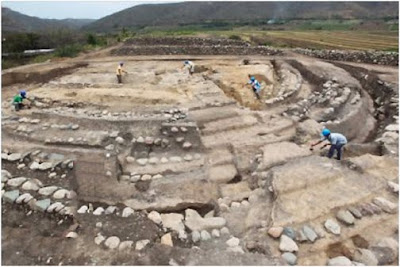Cajamarca dates back to the latter half of the last millennium B.C., into the Chavin period (900 to 200 B.C.) which is believed to have stretched as far south as Lima, Peru, where a magnificent temple (Chavin de Huantar), especially known for its successful drainage system of several canals built under the temple that acted as drainage. In addition, the water rushing through the canals during the rainy season creates a marvelous acoustic sound of power, as though a jaguar—their asacred animals—was roaring nearby. The granite and black limestone used to build the temple had to be brought from some distance away, though there were numerous local rock deposits nearby.
The Chavin also demonstrated advanced skills and knowledge in metallurgy, soldering, and temperature control. They used early techniques to refine gold work, and domesticated camelids for pack animals, fiber and food. They also cultivated several crops, including potatoes, quinoa, and maize, along with irrigations systems to assist in the growth of these crops.
Chavin art dates to 500 to 200 B.C., and is considered the first widespread, recognizable artistic style in the Andes. The Chavin decorated the walls of their temples with carvings, sculptures and pottery, and in at least one case, the art on an obelisk is considered to depict the creation story.
 Yellow area shows Chavin sphere of influence, darker yellow shows Andes area, red dots are the Chavin centers, though they overlapped into other civlizations of their time
Yellow area shows Chavin sphere of influence, darker yellow shows Andes area, red dots are the Chavin centers, though they overlapped into other civlizations of their timeThe Chavin also had a wide sphere of influence throughout the surrounding civilizations, from the Ecuador border to Piura on the far north coast to Paracas on the south coast, and from to Pucara in the south highlands to the northeast area of Peru.
Less than 10 minutes from the center of Jaén (near the red dot shown as Chavin on the map), a group of researchers unearthed two temples, which according to early indications, belong to a culture that could be as much as 4000 years old and would have been the ancestors of the Bracamoros culture, who straddled the present-day Peru-Ecuador border, which would be to the line separating the Land of Bountiful from the Land of Desolation (Alma 22:32).
 When archaeologists started work they found large semicircular walls, first made of mud mortar then others made of stones weighing up to 440 pounds. The team was surprised by the technique used to decorate the walls with different color mud, and because the eight phases of construction were in perfect alignment. Perhaps most astonishing is that the temples, according to Quirino, appear to have been built around 2000 BC… some 4000 years ago—and is believed to be the earliest civiliztion of Peru. Remains in the temple show that the builders and users of the temples had contact with the coast as well as the Amazon area.
When archaeologists started work they found large semicircular walls, first made of mud mortar then others made of stones weighing up to 440 pounds. The team was surprised by the technique used to decorate the walls with different color mud, and because the eight phases of construction were in perfect alignment. Perhaps most astonishing is that the temples, according to Quirino, appear to have been built around 2000 BC… some 4000 years ago—and is believed to be the earliest civiliztion of Peru. Remains in the temple show that the builders and users of the temples had contact with the coast as well as the Amazon area.The excavations were carried out under an integration program between Peru and Ecuador, which includes the basins of the rivers in May, Chinchipe, Marañón, Utcubamba and Puyango-Tumbes.




No comments:
Post a Comment